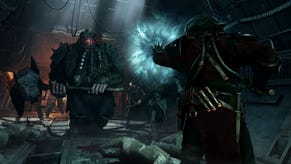Can Warhammer 40,000: Darktide on Xbox match the high-end PC experience?
A creditable effort with frustrating issues to address.
Warhammer 40,000: Darktide is a rare thing in modern gaming: a PC-centric release, based on unique game engine technology. When it launched last year, it certainly stood out from the crowd with detailed, evocative visuals and extremely detailed environmental artwork, along with extensive ray tracing features. However, it also arrived with a variety of performance issues, from network stability problems to frame-time hitching, even for those with higher-end kit. The game's brand-new port to Xbox Series consoles is an interesting opportunity to see just how well the game can scale to a lower-end fixed platform. Can Series X get anywhere close to a high-end PC experience, and what about Series S?
Darktide looks surprisingly impressive for a multiplayer-centric game. Most multiplayer titles sacrifice visual fidelity to achieve higher frame-rates and effectively target a wider range of potential hardware configurations, but this game is very different. For starters, there's an extreme level of environmental detail in each gameplay space.
 Warhammer 40K Darktide - Xbox Series X/S Tech Review - Can Consoles Handle A High-End PC Juggernaut?
Warhammer 40K Darktide - Xbox Series X/S Tech Review - Can Consoles Handle A High-End PC Juggernaut?
If you take a close look at virtually any surface in Darktide, it has an intense amount of detail. The game is mostly set in indoor environments made of angular stamped metal and draped in wires and pipes, all of which hold up even at extreme close range. Everything is "greebled" or covered with nonfunctional bits of detail, that greatly enhance the complexity of the game environments. This is mostly accomplished through a mix of a high geometric density and parallax mapping - a genuine surprise for a co-op shooter.
The high quality game's lighting is also very evocative. It looks like a pre-computed 'baked' solution for global illumination, which convincingly portrays the movement of light through each tight interior space. Artistically speaking, each area is flooded with quite distinctive coloured lighting, so all the maps are easily distinguishable from each other at a glance. Darktide makes heavy use of volumetric lighting as well, which really enhances the atmosphere. The player flashlight lends the game dramatic flair, and each pulse of weapons fire convincingly illuminates the surrounding area too.
Combat is very pleasing too. Enemies come in huge hordes, dispatched with weapons fire at a distance or melee swings up-close. They break apart into gory bits seemingly with the application of any force whatsoever, which feels very satisfying. In the heat of combat, with guns firing wildly and players desperately hacking and slashing, coupled with beautiful volumetric lighting and accurately-lit smoke in the background, the game often looks very striking.
Darktide is an especially notable visual accomplishment because it uses in-house technology, specifically a custom branch of the deprecated Autodesk Stingray game engine, to power its graphics. This is a current-gen only game that manages to sit with some of the best titles we've seen so far in the ninth generation era of console and PC hardware, despite a multiplayer focus and the use of custom engine tech. Third-party studios rarely take such a bold approach, but it's definitely paid off for developer Fatshark.
Xbox Series X ships with quality and performance modes, targeting 30fps and 60fps respectively, as you may expect, while Series S only has the one 30fps mode. Putting the Series X presentations side-by-side, there's an immediately apparent difference in image quality. The game looks messy in the performance mode with visible aliasing in virtually every shot. All of the super-fine geometric detail simply doesn't resolve properly here. Darktide doesn't present an especially clean image to the player regardless of mode, but this is masked to some degree by the higher image resolution in the quality mode. There's a dynamic resolution system in play, averaging at around 864p in performance mode, rising to 1368p in the quality alternative, though the dynamic figure varies according to content.
Otherwise, visual settings are the same - but the quality of the presentation is about more than just the resolution. Darktide's anti-aliasing, which is a form of TAA, has some odd properties. In motion, edges are smoothed out reasonably well, but as soon as the camera stops, those hard- jagged edges return. Perhaps Fatshark is simply trying to minimise aliasing in motion and doesn't like the look of their TAA when the image is stable, or perhaps this is a bug. In either case, I found it quite off-putting, because when the camera is still there's very little anti-aliasing coverage whatsoever.
Series S gets just one visual mode, which targets 30fps. Compared against the Series X performance mode, it looks quite similar. The game suffers from substantial aliasing, though again the image actually has more effectively anti-aliased edges in motion. The overall presentation is a little cruder than Series X, with harsher jagged edges and a rougher portrayal of fine details. That's because resolution has been cut down further, averaging around 720p. It's a pretty harsh cutback for Microsoft's junior console, and makes the lack of a 60fps performance mode here quite understandable - the image would simply look too rough.
So, how close does Series X get to the PC game? Image quality is a big concern on consoles, and the PC version doesn't seem to exhibit the same issues, suggesting that there's something uniquely wrong with the anti-aliasing solution on consoles. However, PC's improved TAA has stability problems not seen in the console version. Ultimately, judging from the PC code I think AMD's FSR 2 would have been a better option, as it delivers a higher-quality image treatment than the default TAA alongside a substantial performance advantage. In both the areas where the console TAA and PC TAA fail, FSR 2 is delivering much better results, which makes its exclusion a little odd here.
In terms of visuals, the consoles do get close to the maxed PC experience - with one exception: ray tracing. It's completely missing on consoles. The PC version packs RT reflections and a probe-based RTGI, which increase the fidelity of the lighting significantly. The RT reflections add all kinds of subtle reflective detail on glossy to semi-matte surfaces, which feel very nicely integrated into the environment. They don't really stand out too much, but they do add a lot to the visuals. RT reflections don't seem to be present on transparent surfaces, however, on either platform, with cubemaps used instead. The RTGI gives Darktide's lighting more granular detail in hard-to-light spots like around complex geometry and in the vicinity of intense light sources. This is a subtle improvement over the baked GI that is otherwise used in this title, but it fixes some of the more obvious issues present in the standard rasterised solution
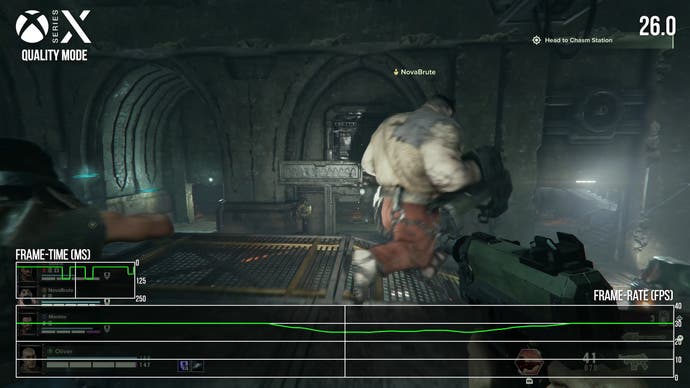
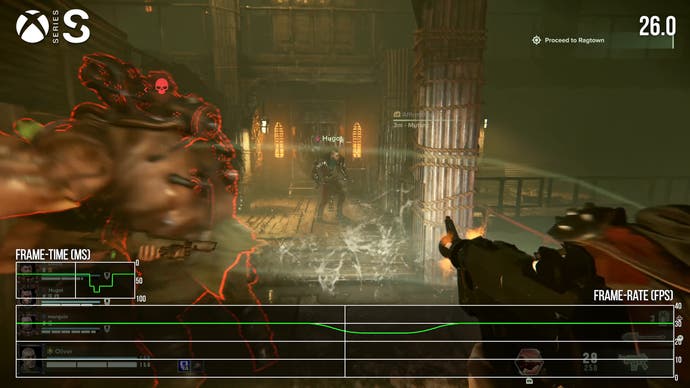
Performance in Darktide is, unfortunately, a bit of a mixed bag on consoles. In the Series X quality mode, Darktide runs at a pretty consistent 30fps, even in intense firefights. However, the title suffers from occasional hitching, compromising the experience with a barrage of high-latency frames. Outside of these moments, you do get a decent enough 30fps update, though motion blur would stand to improve from a lengthened shutter speed, which would make the game feel a lot more fluid in motion. Series S follows a similar pattern. Microsoft's junior console hits and holds a stable 30fps, punctuated occasionally by frame-time stumbles. It's about the same as the more powerful console in general play, with the same somewhat unstable feel.
The Series X also packs a performance mode, of course. This option aims for 60fps, but often falls short. Extended frame-rate dips are common, and harsh stutters pop up from time to time as well. In general play it's usually reasonably close to 60fps or at 60fps in our metrics, but the overall frame-rate fluidity isn't as good as it should be. Still, this would be my preferred way to play the game at the moment, as Darktide just feels a lot better with a faster cadence of frames, even if there are still some inconsistencies and obvious frame-time stutters.
Beyond the frame-rate figures, Darktide has some issues with networking. Player cams in co-op update at a jerky, irregular pace, This is a common problem in multiplayer titles but it feels especially intrusive here. And when walking around the environment slowly, my position within the gameworld sometimes failed to update for a frame, making the game appear to judder despite a solid frame-rate readout. I didn't notice this problem during the game's single-player prologue, so I suspect this is caused by synchronisation issues during network play.
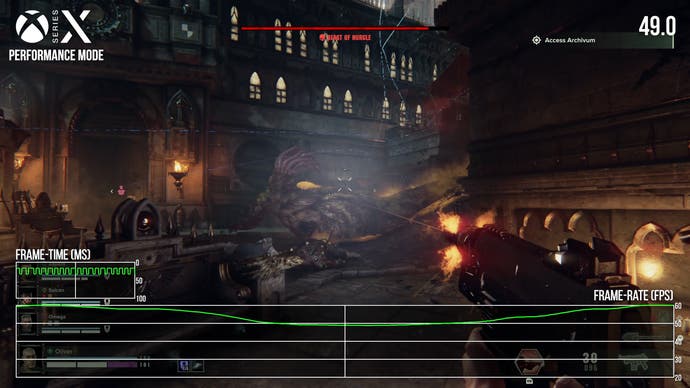

Graphics aside, Warhammer 40,000 Darktide is an entertaining co-op adventure. You embark upon individual missions from a central hub, matchmaking with three other players into one of 14 missions, set across five distinct locations. The gameplay is akin to Left 4 Dead and isn't too far removed from a modern extraction shooter, though here the focus issquarely on combat. I did have a fun time with the game, though I do wish the developers added some force feedback when firing guns or swinging bladed weapons, as combat feels a bit floaty without it.
It's also very beautiful of course, with a stunning level of detail and impressive lighting throughout. I'm not a big Warhammer fan myself, but judging from the miniature sets, I think Fatshark has done a superb job translating the Warhammer 40,000 aesthetic to real-time 3D. It's exactly what you'd expect if you liberated the figurines from the isometric constraints of tabletop play, and piled on extra detail while retaining the series' signature stylisation.
However, the odd anti-aliasing configuration does leave something to be desired, the PC's ray tracing features are totally absent and the game comes saddled with a few performance annoyances that make it feel a bit unstable. Darktide is a visually impressive title that is let down a bit by some unfortunate quirks. Still, players who are interested in the idea of a co-operative shooter set in the grim Warhammer 40,000 universe will find a lot to like here. I just hope to see the developer improve on the various issues I encountered in my experiences with the game.
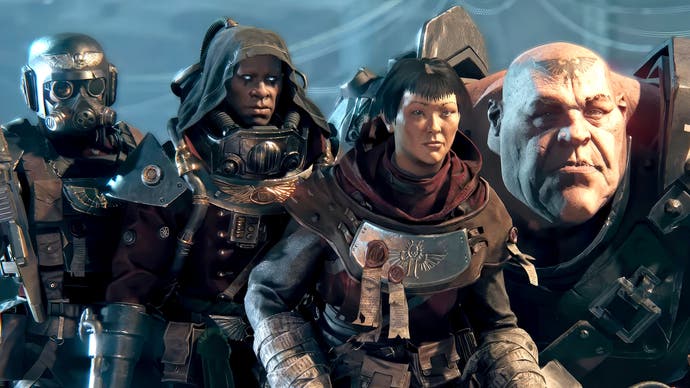



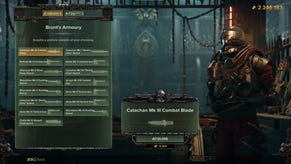

.jpg?width=291&height=164&fit=crop&quality=80&format=jpg&auto=webp)
